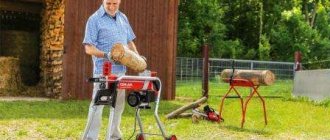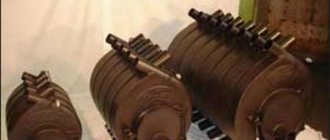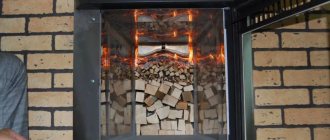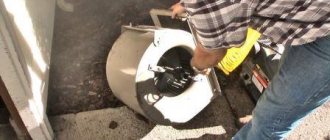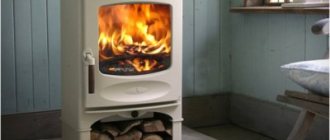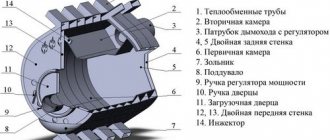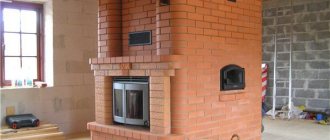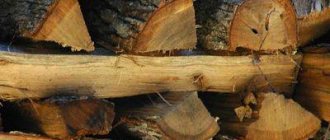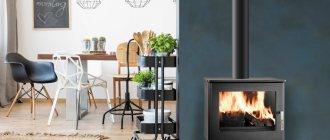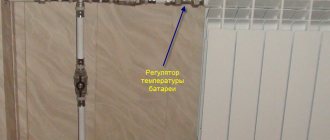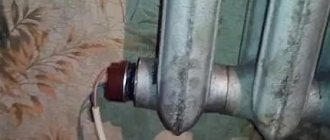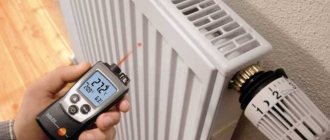Few people know that the choice of a chimney system directly depends on the temperature of the exhaust gases during fuel combustion in the boiler. Ignoring this important point leads to the fact that soon after assembling the chimney, the metal pipe or brick structure crumbles, so repairs and financial costs cannot be avoided. To understand why this happens, you need to understand the operating features of gas boilers.
Important nuances
In solid fuel boilers, fuel burns at a high temperature, so the exiting gases have a high temperature (usually about 300 degrees, although the values may vary up or down). The situation is completely different with gas boilers.
Modern gas equipment used for space heating has an important feature - the temperature of the combustion products leaving does not exceed 120 degrees, and sometimes is significantly lower than this mark. This is due to the desire of manufacturers to increase the efficiency of gas boilers. This desire also has its negative sides. The lower the temperature of the exhaust gases, the more condensate forms inside the system. Condensate contains aggressive substances and therefore has a destructive effect even on stainless steel pipes. In general, unpleasant consequences can be prevented if you take into account several important nuances.
The temperature of the exhaust gases directly depends on the radiator settings. If heating radiators heat up to a temperature of 65 degrees, the combustion products will have a low temperature. When using a heated floor system, in which the water is heated to only 35 degrees, the temperature of the gases will be even lower and there will be more condensation.
When does firewood produce more heat?
To organize economical heating of a private home, you need to extract maximum thermal energy from wood, and then transfer it to the premises with minimal losses. The second condition depends on the efficiency of the heat source, but the first one depends precisely on the temperature of burning wood in the furnace or boiler. The higher it is, the more heat is released.
The amount of heat generated when wood burns (heat output) is influenced by the following factors:
- caloric content (the amount of thermal energy that can be obtained from a unit of fuel);
- natural moisture content in wood;
- volume of supplied air and its temperature.
In practice, all of the above parameters are interconnected. The calorie content of fuel supersaturated with moisture is approximately 2 times lower than that of dry wood. And without the required volume of air, it will begin to smolder and emit minimal heat. That is, the real combustion temperature of wood is not a constant value and cannot be accurately indicated in theoretical considerations.
For reference. There is a simple way to determine what fire temperature is reached when burning wood in an open firebox. Use an infrared pyrometer that measures the heating of surfaces from a distance, as the master stove maker did in his video. It demonstrates testing of a barbecue fireplace insert; measurements are taken in the second half of the video.
Now let's look at each factor separately.
About the calorific value of fuel
Different types of wood differ in density and weight, and also contain different amounts of carbon and hydrogen - the main components that produce heat during the combustion process. As a rule, denser and heavier species, such as oak and ash, provide more energy than poplar or alder. We present to your attention a table with data on the density, specific heat and combustion temperature of various types of wood.
Note. The table shows the values of the mass and volumetric heat of combustion of dry fuel per 1 kg and per 1 m³ of storage. The maximum temperature is based on ideal combustion conditions with excess air.
If we compare the calorific value by volume, it is noticeable that oak or birch logs will emit more heat than less dense coniferous species. And although the conditions for burning wood in a stove, potbelly stove or boiler are far from ideal, the trend will still persist. That is, the flame temperature directly depends on the calorific value of the selected wood species.
Real heating rate at the center of the flame
Effect of humidity
High moisture content is the first enemy of effective heat transfer during combustion of any biomass. Freshly cut wood with a moisture content of 50-65% will never provide the indicators shown in the table above, and here’s why:
- As the firebox heats up, the water contained in the logs absorbs part of the heat generated.
- When the firewood has burned well and produced enough heat, the moisture from the liquid phase passes into the vapor phase, taking away the lion's share of the energy received. Since hot steam leaves the firebox along with flue gases, it is impossible to return the lost heat.
- Wet wood requires a higher temperature to ignite. It is quite difficult to light them with a match and a piece of paper; you need to use a gas burner.
For reference. Some of the water vapor condenses from contact with the walls of the chimney, which releases a small fraction of thermal energy. Only it heats the pipe, not your home.
How much the calorific value, and subsequently the burning temperature of wood, decreases depending on humidity is shown in the following table:
It is easy to see that the heat transfer of freshly cut firewood is half that of dry wood (humidity less than 20%). Accordingly, to heat the house you will have to spend twice as much solid fuel. A separate issue is the stove in the bathhouse, which requires maximum heat for kindling. When using raw wood, it will not be possible to reach a high temperature, no matter how many logs you throw into the firebox. It's all about their weak heat output, which will not allow you to heat the bathhouse properly.
Combustion air consumption
To completely burn wood and achieve maximum temperature in the firebox, it is necessary to supply air in excess of 130% of the required amount. When creating ideal conditions, the carbon oxidation (combustion) reaction is described by a simplified equation:
In words, this means that when heated, wood decomposes into carbon (C) and hydrogen (H), and oxygen (O) is supplied from the outside. Each carbon atom meets 2 oxygen atoms to form carbon dioxide. In turn, hydrogen combines with oxygen residues, which releases water (again, in the form of steam). The Latin Q at the end of the formula means the release of heat used for heating needs.
But what happens if ideal conditions are violated:
- Hydrogen is a very active element, so it oxidizes first. When there is not enough air (you have covered the vent of a furnace or boiler), then carbon remains without oxygen molecules. As a result, unburned carbon monoxide (CO) is formed, which flies out into the chimney along with the smoke.
- With a total lack of oxygen (the so-called smoldering regime), carbon turns into charcoal, ash and soot. The latter, under the influence of the chimney draft, also rushes into the pipe and settles on its walls.
- An excess of air occurs due to strong chimney draft or improper operation of the boiler turbocharging. The phenomenon is fraught with heat loss through the chimney.
Note. A fire is an example of a heat source with an uncontrolled air supply. The more it is, the lower the fire temperature in the fire and the less heat output. To keep warm near the fireplace for a long time, logs must be added continuously.
An obstacle to obtaining good heat from firewood can be the temperature of the air supplied to the combustion chamber. Cold air flow is just as effective at removing precious heat as water vapor. It is not for nothing that manufacturers of high-quality heating units arrange a special channel for heating air from the outer walls of the firebox. How this is implemented in practice is shown in the photo of a homemade solid fuel boiler from our expert.
The air duct from a profile pipe is heated by the rear wall of the fuel chamber, and the fan is placed on top of the flange
When choosing a chimney, consider the boiler power
When choosing a chimney system, it is necessary to take into account the power of the gas boiler . The higher the power, the higher the combustion temperature of the fuel will be. This is sure to be reflected in the escaping gases. The power value helps to choose the correct pipe diameter and length. For example, a 300 kW boiler requires a pipe with a diameter of 150 mm.
Typically, the instructions for use indicate not only the technical characteristics of the heating equipment, but also provide recommendations for the selection and installation of a chimney system. If necessary, seek help from a specialist if you yourself cannot correctly calculate the optimal parameters of the chimney pipe.
Which material should you prefer?
Nowadays, stainless steel chimneys are very popular on the market. They are used for boilers of various types, although this approach is fundamentally wrong. If you plan to install a gas boiler , you need to decide what material the chimney should be made of. Don't rush to buy metal pipes. They are excellent for solid fuel boilers, as they can easily withstand high temperatures.
For gas boilers, which are characterized by low temperatures and large amounts of condensate, it is preferable to choose plastic or polymer pipes. Their main advantage is good resistance to moisture. Because of this, they usually last longer than metal chimneys. FuranFlex pipes are excellent for gas boilers, which are characterized by excellent resistance to aggressive substances, strength and durability.
If you use a gas-wood combination boiler , you will have to abandon the use of FuranFlex. The fact is that polymer pipes are produced in two versions - for high and low temperatures (solid fuel and gas boilers, respectively). Polymer stockings cannot be used effectively at high and low temperatures at the same time.
Features of repair work to restore the chimney
If repair of a gas boiler , or rather its chimney system, is required, the most effective solution would be to use FuranFlex technology. When installing a polymer stocking, there is no need to perform dismantling work. The FuranFlex pipe is inserted into the chimney from the inside, and after hardening it serves as support and protection. It prevents further destruction, while the material itself has excellent performance characteristics. The main thing is to choose the right type of material, but our employees are always ready to help in resolving this issue. They will advise you on all your questions.
Similar articles:
You have questions? We can call you absolutely free!
We will contact you and answer any questions you may have!
What is the combustion process
Combustion is a process at the boundary of physics and chemistry, consisting in the transformation of a substance into a residual product. In this case, thermal energy is released in large quantities. The combustion process is usually accompanied by the emission of light, which is called a flame. Also, during the combustion process, carbon dioxide is released - CO 2, an excess of which in an unventilated room can lead to headaches, suffocation and even death.
For the process to proceed normally, a number of mandatory conditions must be met.
Firstly, combustion is possible only in the presence of air. Impossible in a vacuum.
Secondly, if the area in which combustion occurs is not heated to the ignition temperature of the material, then the combustion process will stop. For example, the flame will go out if you immediately throw a large log into a newly lit stove without allowing it to warm up on small wood.
Thirdly, if the subjects of combustion are damp and release liquid vapors, and the burning rate is still low, the process will also stop.
